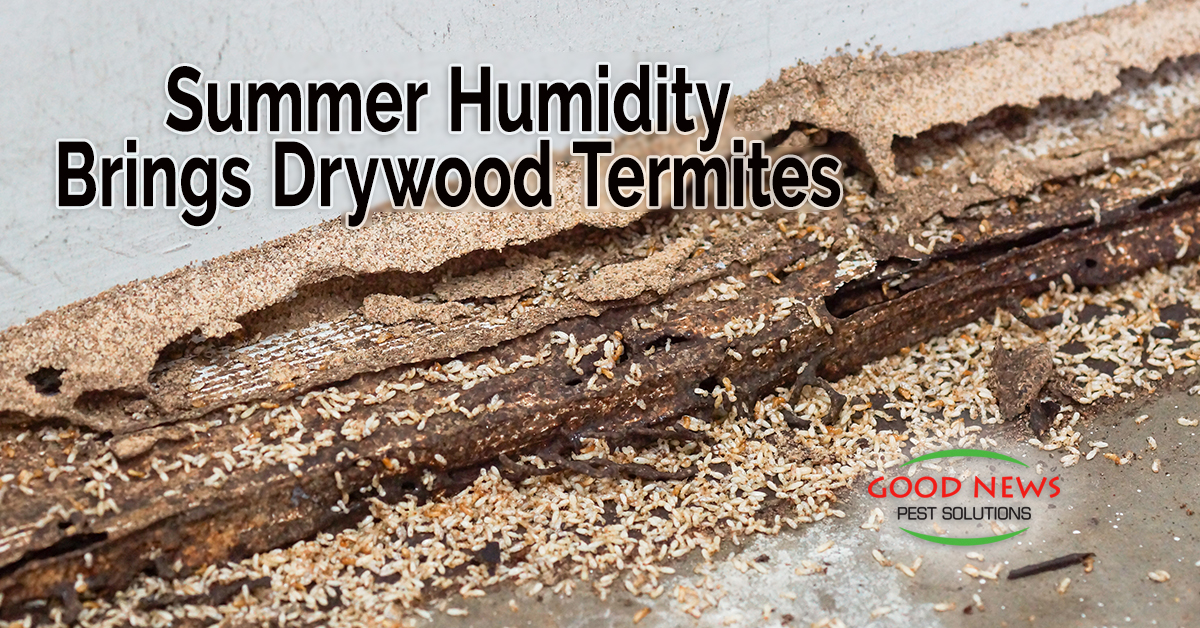
Summer Humidity Brings Drywood Termites
If you’re flipping through your Farmer’s Almanac – okay, maybe the online app - you might notice that Summer officially started earlier this week – June 21st to be exact. Of course, here on the Gulf Coast of Florida that’s just a date. Summer is more of a calendar notation with the weather not fluctuating too awfully much during the year. Once the rainy season starts in mid-May, we know how things are going to go down.
But our wonderful subtropical weather that we all enjoy is also of interest to the insect world. Specifically, drywood termites.
Swarming Season
There are four main types of drywood termites we see here in Florida – and yes, as we’re fond of saying everyone’s either got termites or will soon have them. Again, our subtropical weather keeps them active nearly year round. But there are certain times of the year that they tend to be even more active.
The western drywood termite swarms pretty much anytime but December. The tropical smooth-headed drywood termite is known to mostly swarm in the afternoon between March and May. The southeastern drywood termite typically swarms overnight in the spring. And from April through July the tropical rough-headed drywood termite swarms at night.
Unlike their subterranean cousins, drywood termites infest dry wood and do not require contact with the soil. In fact, when the average person thinks of termites, this is generally what comes to mind: termites infesting the floorboards, furniture and wooden foundation and siding.
Thankfully, unlike subterranean termites, drywood termites tend to be found in smaller swarms and cause less damage on the whole, but multiple colonies can infest a single structure. Unless they’re swarming, drywood termites are seldom seen, preferring to stay hidden within the wood they’re chowing down on.
Signs of Infestation
Because swarming season is one of the few times you’re likely to “catch” termites out and about – alates flying about to mate – it’s good to be on the lookout now, hopefully noticing you have an issue before it becomes larger.
The biggest sign to look for are fecal pellets. Typically termite poop is tiny, light beige to black, (depending on the wood they’re eating) and are oval-shaped with six concave sides. What you’ll typically see looks like a little pile of sawdust. Sometimes you’ll see a little bit on a windowsill or doorframe – often it’s only when the swarmers exit the wood to fly around that the little piles are pushed out.
Watch for winged insects attracted to the light or the TV in the evening and discarded wings in spider webs and window sills.
If you suspect termite infestation, you can tap on the wood to see if it sounds hollow or seems thin. Sometimes the wood will start to blister, like the paint is getting older. A papery rustling sound is an indicator that there are tunnels just below the surface of the wood. When the drywood termites are eating they cut across the grain of the wood – and they devour both soft and hard wood.
Winged termites have thicker waists and straighter antennae than flying ants, and drywood termites’ wings are equal in length. Flying ants look more wasp-like and have shorter hind wings than fore wings.
Treating the Problem
As we already mentioned, drywood termites routinely do less damage and are easier to deal with than the subterranean varieties. Sometimes it’s only a piece of furniture or section of a room or wall that needs to be removed and dealt with. Usually the problem may be larger, so you should always call a professional to diagnose exactly how extensive your termite problem is. You also don’t want to mistake subterranean termites for drywood and suffer the consequences.
Good News Pest Solutions has been handling termite problems in Florida for more than 30 years. Our highly-trained associates know what to look for and how to treat it quickly and effectively. Of course, the best way to deal with an inevitable termite problem is to prepare ahead of time.
We are proud to offer the most effective termite preventative – Term Assure 365. Term-Assure is added on to our popular Go Green Perimeter Plus solution. Together they guarantee your home is free from the standard creepy-crawlies we see, like ants and roaches, but Term-Assure 365 also adds on termite monitoring stations that allow us to detect the problem before they get into your home or business. And it comes with a $1-million warranty against damage – much more than your homeowner’s insurance will even consider.
If you’d like to learn more, or get your new home inspected before you move in, just give us a call!
« Back to Blog
Proudly Serving
Sun City Center, Ruskin, Palmetto, Parrish, Ellenton, Bradenton, Anna Maria, Holmes Beach, Bradenton Beach, Longboat Key, Lakewood Ranch, University Park, Myakka City, Sarasota, Siesta Key, Osprey, Nokomis, Casey Key, Venice, Englewood, North Port, Port Charlotte, Punta Gorda, Arcadia
Things You Can Do
Pay Your Bill Online
Leave Us a Review
Request a Free* Termite Inspection
Stop Mosquito Bites
Get Rid of Rodents
Get a Termite Damage Warranty
Get Pest Control for Your Attic
Get Pest Control for Your Business Request Prayer
Corporate Address
1080 Enterprise Court, Ste A
North Venice, FL 34275
Call Now: (941) 412-9610
Text: (941) 412-9610
Fax: (941) 412-0080
